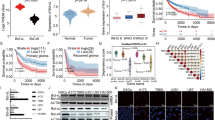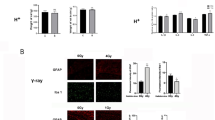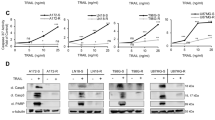Abstract
Heterotrimeric GTP-binding proteins (G proteins) transduce extracellular signals into intracellular signals by activating effector molecules including adenylate cyclases that catalyze cAMP formation, and thus regulate various cellular responses such as metabolism, proliferation, and apoptosis. cAMP signaling pathways have been reported to protect cells from ionizing radiation-induced apoptosis, but however, the protective mechanism is not clear. Therefore, this study aimed to investigate the signaling molecules and the mechanism mediating the anti-apoptotic action of cAMP signaling system in radiation-induced apoptosis. Stable expression of a constitutively active mutant of Gαs (GαsQL) protected γ ray-induced apoptosis which was assessed by analysis of the cleavages of PARP, caspase-9, and caspase-3 and cytochrome C release in SH-SY5Y human neuroblastoma cells. Gα sQL repressed the γ ray-induced down-regulation of Bcl-xL protein, but transfection of Bcl-xL siRNA increased the γ ray-induced apoptosis and abolished the anti-apoptotic effect of GαsQL. GαsQL decreased the degradation rate of Bcl-xL protein, and it also restrained the decrease in Bcl-xL mRNA by increasing the stability following ionizing irradiation. Furthermore, prostaglandin E2 that activates Gαs was found to protect γ ray-induced apoptosis, and the protective effect was abolished by treatment with prostanoid receptor antagonist specific to EP2/4R subtype. Moreover, specific agonists for adenosine A1 receptor that inhibits cAMP signaling pathway augmented γ ray-induced apoptosis. From this study, it is concluded that Gαs-cAMP signaling system can protect SH-SY5Y cells from γ ray-induced apoptosis partly by restraining down-regulation of Bcl-xL expression, suggesting that radiation-induced apoptosis can be modulated by GPCR ligands to improve the efficiency of radiation therapy.
Similar content being viewed by others
Article PDF
Author information
Authors and Affiliations
Rights and permissions
This is an Open Access article distributed under the terms of the Creative Commons Attribution Non-Commercial License (http://creativecommons.org/licenses/by-nc/3.0/) which permits unrestricted non-commercial use, distribution, and reproduction in any medium, provided the original work is properly cited.
About this article
Cite this article
Kim, SY., Seo, M., Oh, JM. et al. Inhibition of γ ray-induced apoptosis by stimulatory heterotrimeric GTP binding protein involves Bcl-xL down-regulation in SH-SY5Y human neuroblastoma cells. Exp Mol Med 39, 583–593 (2007). https://doi.org/10.1038/emm.2007.64
Published:
Issue date:
DOI: https://doi.org/10.1038/emm.2007.64
Keywords
This article is cited by
-
Radioprotective effect of geraniin via the inhibition of apoptosis triggered by γ-radiation-induced oxidative stress
Cell Biology and Toxicology (2011)
-
GNAS1 T393C polymorphism is associated with histopathological response to neoadjuvant radiochemotherapy in esophageal cancer
The Pharmacogenomics Journal (2009)
-
ATG5 expression induced by MDMA (ecstasy), interferes with neuronal differentiation of neuroblastoma cells
Molecules and Cells (2009)



